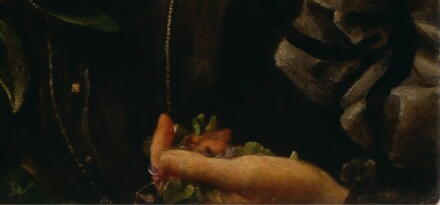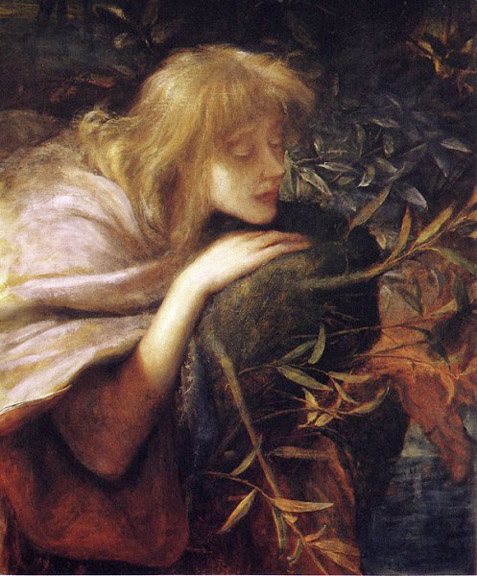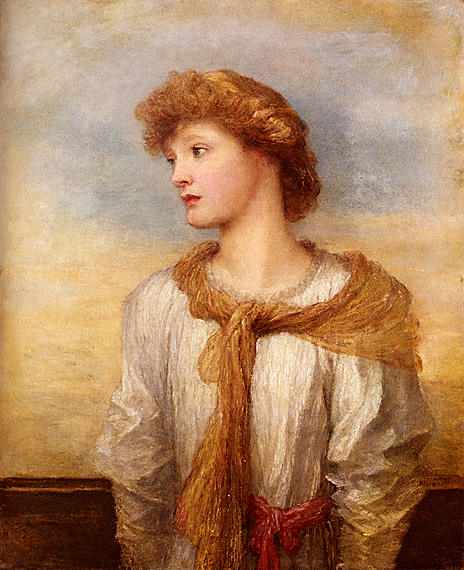George Frederic Watts - Muses & the Beau Monde
- Lilium

- Nov 25, 2020
- 6 min read

George Frederic Watts, born 23 February 1817, was a British painter and sculptor associated with the Symbolist movement.

Watts was widely considered to be the greatest painter of the Victorian era. A portraitist, sculptor, landscape painter and symbolist, Watts's work embodied the most pressing themes and ideas of the time, earning him the title England's Michelangelo.
Watts had a symbolist vision and was a pioneering artist, although he refused to attach his work to any particular movement. He saw art as a refuge from the ills of society and painted scenes of mysticism and otherworldliness.
Much like in the post on Dante Gabrielle Rossetti, I will explore the symbolism in Watt's work and the meaning in the delicate details.

Sir Galahad
Sir Galahad was painted by Watts from 1860-62. Sir Galahad was a knight of King Arthur's Round Table and one of the three achievers of the Holy Grail in Arthurian legend. He is the illegitimate son of Sir Lancelot and Elaine of Corbenic, and is renowned for his gallantry and purity as the most perfect of all knights.
The story goes that upon reaching adulthood, Galahad is reunited with his father Lancelot, who knights his son after being defeated by him. Galahad is then brought to King Arthur's court at Camelot during Pentecost, where he is accompanied by a very old knight who immediately leads him over to the Round Table and unveils his seat at the Siege Perilous, an unused chair that has been kept vacant for the sole person who will succeed in the quest of the Holy Grail.
For all others who have aspired to sit there, it had proved to be immediately fatal. Galahad survives this test, witnessed by Arthur who, upon realising the greatness of this new knight, leads him out to the river where a magic sword lies in a stone with an inscription reading "Never shall man take me hence but only he by whose side I ought to hang; and he shall be the best knight of the world." (The embedding of a sword in a stone is also an element of the legends of Arthur's original sword, the sword in the stone. In Malory's version, this is the sword that had belonged to Balin.)
Galahad accomplishes this test with ease, and Arthur swiftly proclaims him to be the greatest knight ever. Galahad is promptly invited to become a Knight of the Round Table, and soon afterwards, Arthur's court witnesses an ethereal vision of the Grail. The quest to seek out this holy object is begun at once.
It is Galahad who takes the initiative to begin the search for the Grail. For the most part he travels alone during the Grail Quest, smiting (and often sparing) his enemies, rescuing fellow knights including Percival (who Watts also painted) and saving maidens in distress. After many adventures, Galahad and Percival find themselves in the mystical castle of Corbenic at the court of Pelles where Galahad discovers the Holy Grail.

There is a stained glass window is by Watts in All Saints' Church, Freshwater, Isle of Wight, based on an 1862 painting of Sir Galahad.
Watts used his wife, actress Ellen Terry, as the model for Galahad, giving the knight an androgynous beauty. They spent their honeymoon at Freshwater.
A quote from Tennyson's Sir Galahad features on the window. Tennyson's wife, son and other family members are buried at the church.
"My strength is as the strength of ten, because my heart is pure"

Choosing
This delicate yet sensuous portrait shows the seventeen-year-old Ellen Terry choosing between the camellias, which despite their luscious appearance have little scent, and the violets in her hand which are far humbler in appearance but smell sweeter.
The choice, which is symbolic of that between worldly vanities and higher virtues, had a personal significance for the artist and the sitter.
The painting was created in 1864, which was the year in which Terry gave up the stage to marry Watts, thirty years her senior, and to be educated by him. The marriage lasted barely a year, and despite Watts's disapproval, Terry eventually returned to the stage in 1872
She establish herself as a leading actress with the Bancroft's and John Hare's company. She performed her most memorable roles under the management of Henry Irving with whom she undertook provincial tours and toured America seven times. In later life she continued to act but also produced plays, lectured and wrote.
Late Victorian England was so smitten with Terry that it was popular for young men in the 1880s to propose by saying, “Well if Ellen Terry won’t marry me, will you?” Men and women obsessed over the actress; in fact, she was frequently mobbed in the streets of London. Oscar Wilde made Terry a patron saint of the theater by referring to her as “Our Lady of Lyceum.”
The painting, according to Watts’s biographer Wilfred Blunt, captures Terry “wearing the brown silk wedding-dress designed for her by the Pre-Raphaelite painter Holman Hunt, trying to decide between the rival merits of a showy, scentless camellia and the humble but fragrant violets held close to her heart."

Paulo and Francesca
Paolo and Francesca was painted by Watts in 1870, depicting a scene from Dante's Inferno depicting Paolo and Francesca.
Paolo and Francesca were illicit lovers in 13th century Italy, with a love story that, like all good love stories, ends in tragedy.
Francesca was married off to Paolo's brother Giovanni, despite being madly in love with the handsome Paolo. They have an affair and when Giovanni discovers them together, kills them both.
The poet, Dante Alighieri, a contemporary of Paolo and Francesca, took their story and wove it into his famous poem, Divine Comedy. Although it is not know whether or not Dante actually knew them personally their tragedy had certainly caught his imagination.
In Canto V of the Inferno section, Dante, accompanied by the Roman poet, Virgil, meets the spirits of Paolo and Francesca as they are swept about by eternal winds, just as they allowed themselves to be swept away by their passions and so they are punished forever for their sin of uncontrollable lust. Dante seemed to want to mitigate the blame for their crime somewhat so he originates the story that the couple were influenced by the reading of the adulterous romance of Lancelot and Guinevere.
In the painting Watts shows the ghostly lovers caught in the strong eternal winds,
which blows the drapery of Paolo's cloak and Francesca's long blonde hair around them.
Watts showed his moving first version of Paolo and Francesca at the British Institution, and this may have suggested the theme to Rossetti who went on to paint the lovers many times. Watts painted multiple versions Paolo and Francesca, giving them different features in each version. In Dante's story Francesca's story strikes such a chord within Dante that he faints out of pity. He can be seen with Virgil in the lower right corner of the third picture below.

Hope
The picture, painted in 1886, is one of a series of allegorical subjects which Watts intended for a decorative scheme known as the 'House of Life'. Traditionally the figure of Hope is identified by an anchor, but Watts was seeking a fresher, more original approach.
Radically different from previous treatments of the subject, he painted blind Hope seated on a globe and playing on a lyre which has all its strings broken except one. She bends her head to listen to the faint music, but her efforts appear forlorn; the overall atmosphere is one of sadness and desolation rather than hope. The picture's sense of melancholy is enhanced by the soft brushwork and the translucent mists that envelop the floating globe. The background is almost blank, its only visible feature a single star.
Watts intentionally used symbolism not traditionally associated with hope to make the painting's meaning ambiguous. While his use of colour in Hope was greatly admired, at the time of its exhibition many critics disliked the painting. Hope proved popular with the Aesthetic Movement, who considered beauty the primary purpose of art and were unconcerned by the ambiguity of its message.
Watts appears to have drawn on several contemporary sources for the figure of Hope. Her pose is comparable to Rossetti's siren in A Sea Spell of 1877 (Fogg Art Museum, Harvard University) and also recalls Albert Moore's sleeping women in Dreamers (1882, Birmingham City Museum and Art Gallery). The bandaged head, denoting blindness, may be linked to the allegorical figure of Fortune in Burne-Jones's The Wheel of Fortune (c.1871, Tullie House Museum and Art Gallery, Carlisle), which was once owned by Watts.
Watts painted two versions of Hope and believed the second picture to be the better version and exhibited it at the South Kensington Museum and at the Exposition Universelle in Paris in 1889. This version is softer in execution and the girl wears a more enigmatic expression on her face. Watts also omitted the star, the only note of optimism, at the top of the picture.
It has been suggested that the mood of desolation may reflect Watt's own sadness at the death of his adopted daughter Blanche's one-year old child. Despite its sense of gloom, the picture was well received and proved extremely popular with the public.
Despite the decline in Watts's popularity, Hope remained influential. Martin Luther King based a 1959 sermon, now known as Shattered Dreams, on the theme of the painting.
Reading Recommendations & Content Considerations
A Biography of George Frederic Watts Victorian Visionary
William Blunt Mark Bills & Barbara Bryant


































































































Comments